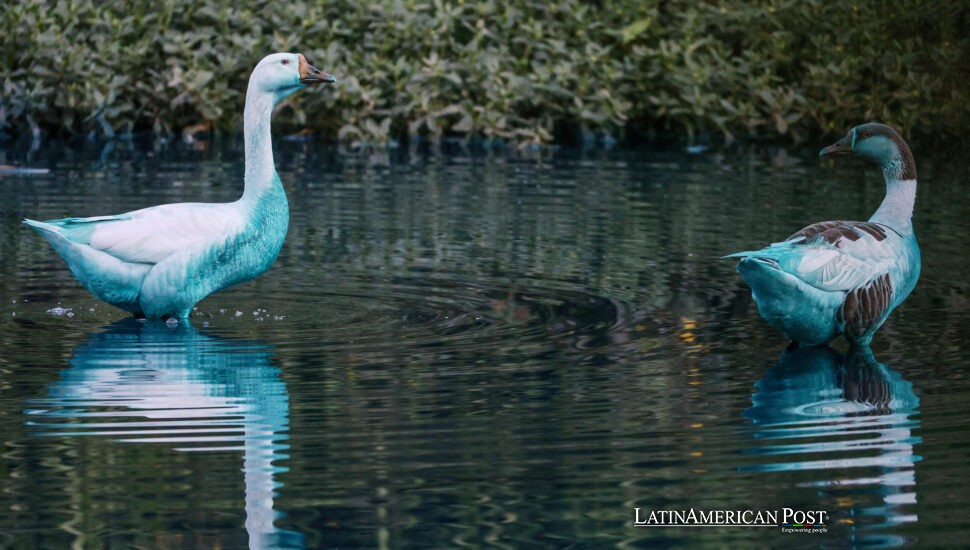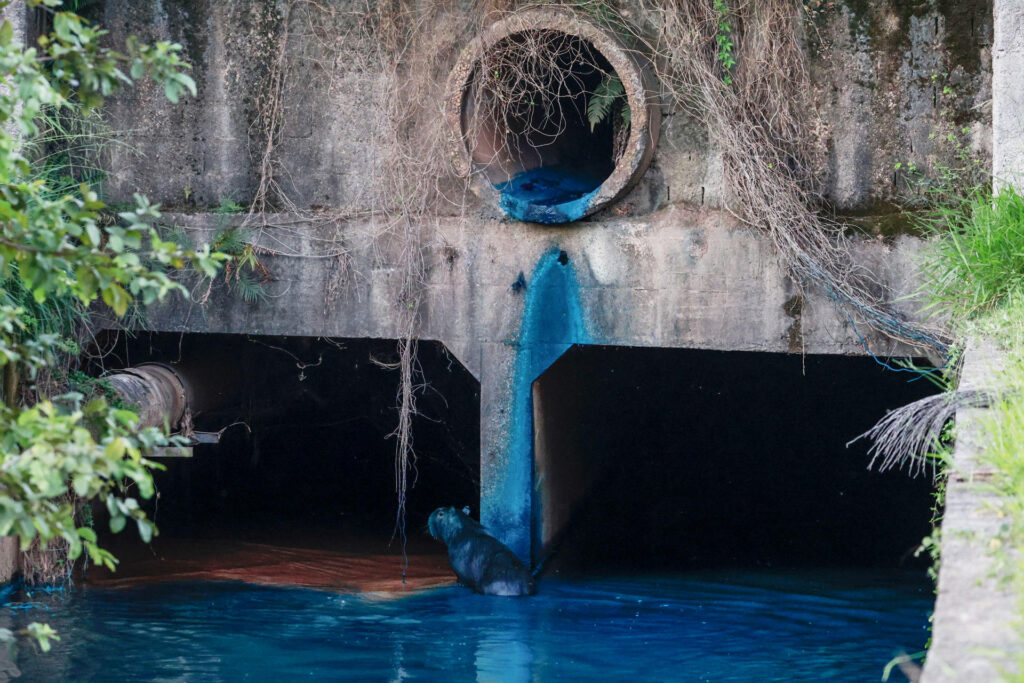Brazil Battles a Surreal Lake Disaster as Blue Dye Runs Rampant

An accidental dye spill has turned a once-tranquil lake and its wildlife electric blue near São Paulo, Brazil. This bizarre and unsettling spectacle has alarmed conservationists, puzzled locals, and sparked a debate about how best to prevent future environmental catastrophes.
A Sudden Splash of Blue
Jundiaí is approximately 75 kilometers from São Paulo, a center of Brazilian commerce. The municipality has hills that rise and fall, parks with green space, and active communities. The pace in Jundiaí is calmer than the quick speed of the capital. At its heart lies the Jardín Botánico (Botanical Garden), a beloved urban oasis that invites joggers, families, and nature enthusiasts to stroll among native plant species, scenic trails, and a picturesque lake called Lago de las Tulipas.
But in a startling turn of events, the usually placid waters of Lago de las Tulipas turned vivid electric blue two days ago. The transformation was so dramatic that even the local fauna—everything from geese and ducks to fish—acquired a bright, dyed appearance. According to EFE, it all started when a truck carrying five tanks, each containing 1,000 liters of a blue dye solution, was involved in a highway collision. Three of those massive containers spilled onto the asphalt of a major roadway that funnels traffic into São Paulo. The spill was so forceful that it even stained nearby house facades, turning sections of walls and fences into a surreal mural of unintended color.
However, the remaining two tanks rolled straight into the lake, releasing their contents into the water. Within hours, the brilliant azure hue spread throughout Lago de las Tulipas, an important tributary of the Jundiaí River and a key artery coursing through much of the surrounding park. Suddenly, the region’s most cherished green space was awash in fluorescent blue, rendering a scene reminiscent of a science-fiction film or a cartoonish postcard.
“I’ve never seen anything like it,” shared one local observer, as quoted by EFE. The observer asked to remain anonymous but described the sight as “both beautiful and horrifying.” The electric lake might have seemed amusing for children who ambled by, but conservationists and public authorities quickly recognized that the bizarre color shift was an ominous sign for the creatures living within those waters.

When Blue Dye Becomes a Threat
The intense blue dye was initially intended to color pulp-based egg cartons, which typically rely on vibrant, eye-catching hues. At the same time, the colorant itself featured an organic component—acetic acid, also a principal ingredient in ordinary kitchen vinegar—its sudden introduction into a delicate aquatic habitat posed immediate risks to aquatic plants, fish, birds, amphibians, and smaller organisms that form the base of the local food web.
Jundiaí’s Civil Defense unit officials arrived on the scene, determined to assess contamination levels and mitigate further harm. Colonel João Gimenez, the coordinator for the Civil Defense in Jundiaí, assured EFE that “it’s a contaminant, but, fortunately, compared to other chemical products, it’s not as severe. It’s not the worst scenario in the world.” Gimenez emphasized that, while the substance may not be as damaging as a toxic industrial chemical, the lake’s ecology would undoubtedly suffer in the immediate aftermath.
Part of the danger was the drastic drop in the water’s pH level. Fish were particularly vulnerable, as the abrupt change caused “an automatic death the moment the product touched the lake,” said Jorge Bellix de Campos, president of the NGO Mata Ciliar, in an interview with EFE. Bellix de Campos, an agronomical engineer, explained that fish rely on stable water chemistry for survival. Altering the balance abruptly led to a swift and devastating die-off, as evidenced by the dozens—or possibly hundreds—of fish carcasses washing ashore.
Still, the lingering question was what would happen to larger animals. Nearby wetlands support herons, ducks, geese, and other bird species. If these animals ingested too much-contaminated water, they could experience internal damage. Birds are known to have delicate gastrointestinal tracts, which can be badly affected by even relatively benign substances. Indeed, local volunteers and rescue teams from Mata Ciliar had to capture at least three geese and two ducks that had turned a bright, cerulean shade, cleaning them with activated charcoal and specialized detergents.
Blue Birds, Rescues, and Invisible Ecosystem Damage
Photographs of birds with sky-blue feathers appeared online. People responded to the pictures with humor and worry. Mata Ciliar volunteers worked to clean the dye from the animals. In some situations, the color went into the feathers. A few birds lost some feathers during cleaning. The color became lighter with repeated washes. Activated charcoal baths helped the birds remove chemicals from their bodies, giving them a chance to detoxify.
Meanwhile, the lake itself told a sadder story. Bellix de Campos pointed out that “it’s tough to measure the dimension of the damage,” referencing the visible death of fish and the likely eradication of microorganisms. These small life forms, invisible to the naked eye, underpin the entire aquatic ecosystem, providing essential nutrients and energy for other species up the food chain. The spill may also have long-term consequences for frogs, toads, and other amphibians that rely on balanced pH levels for breeding and survival.
Some locals observed birds hovering around the shores, scavenging the dead fish. Concern exists that these birds could, in turn, suffer from ingesting the tainted carcasses. The blue hue in feathers isn’t the only sign that nature has been thrown off its axis. But so far, no mass bird deaths have been reported.
“Right now, there is no telling how far the damage goes,” explained Bellix de Campos. “It could reach beyond just the lake. We have to observe.”

From Fuel Spill to Dye Disaster
In an ironic twist, this is not the first time Lago de las Tulipas has experienced a significant spill. In 2019, nearly 20,000 liters of fuel were accidentally released into the same body of water due to another traffic collision. Fuel contamination often has dire consequences, as it contains harmful hydrocarbons that can decimate fish and insect populations and seep into the soil. The 2019 incident forced local authorities to conduct a massive cleanup operation to salvage the ecosystem.
This latest event is, by many measures, less harmful than a fuel spill. The blue dye, primarily an acetic acid-based product, is considered “organic,” meaning it will degrade more readily than industrial chemicals. Colonel Gimenez expressed relief: “Let’s just say it’s a situation we can contain,” he told EFE. The top priority is to clean up the remnants of the dye and ensure it does not spread to additional waterways.
An estimated 2,000 liters of dye have flowed through local drainage into a neighboring municipality. The silver lining is that no community relies on the water from Lago de las Tulipas for household consumption, according to Domenico Tremaroli, the regional manager for the Environmental Company of the State of São Paulo. “Fortunately, that water is not used for drinking or cooking,” he shared with EFE, highlighting that such an incident could have been vastly more destructive if it had compromised a community’s water supply.
Still, the forward flow of the blue-laden water raises concerns for the Jundiaí River. If the contamination is not monitored and contained effectively, local wildlife downstream may also be affected. The Environmental Company of São Paulo performs repeated tests to track the dye plume’s progress, evaluating water quality at various checkpoints.
The Aftermath and a Slowly Clearing Horizon
In the wake of the spill, cleanup crews equipped with hoses and pumps have worked to mitigate the dye concentration in the lake. Civil Defense teams have also coordinated with local environmental authorities to trap, wash, and rehabilitate other affected animals. So far, the measures are making a difference: officials estimate that within a week, the water in Lago de las Tulipas may lose its electric hue, returning to a more normal coloration and acidity.
However, wildlife experts caution that the lake’s ecosystem will unlikely bounce back overnight. The water chemistry changed suddenly, which has the potential for long-term effects. Breeding cycles, food sources, and the complex aquatic ecosystem may suffer. Conservation organizations want residents and park visitors to report animals showing signs of distress. With reports in hand, rescue teams will intervene quickly.
For the birds already rescued, further observation is required to ensure they haven’t ingested toxic levels of dye or endured damage from the associated acidity shift. “Birds have very sensitive gastrointestinal systems,” Bellix de Campos explained. We have to wait and see if there are any delayed effects.”
Much concern surrounds this situation, but many people think nature possesses a recovery capability that will give some assistance. Aquatic areas often adjust to abrupt disturbances, mainly if the pollutant has a reduced toxicity and disappears or sinks. Gimenez’s happiness at the spill’s non-petroleum composition may be correct. The occurrence brings attention to a concerning fact: even a naturally derived compound can become dangerous when large quantities enter delicate locations.
Tremaroli drew observations from the 2019 fuel event. Local governing bodies and those who study the environment have become more practiced in their reaction to emergencies. “While we never want these things to happen,” he told EFE, “each event gives us more knowledge and better readiness for the next time. It’s a matter of refining our procedures and ensuring rapid action.”
Municipal leaders and environmental advocates in Jundiaí have called for stricter regulations on how trucks carrying hazardous or large-quantity materials navigate the heavily trafficked routes. They suggest the installation of safety barriers that add to the current setup. It also recommends giving truck drivers training specific to their jobs. Another suggestion is strengthening the legal consequences for transportation companies that fail to follow protocols. For local officials to have plans to give thorough, immediate responses should accidental spills happen again, some want environmental impact assessments with more power.
Meanwhile, curiosity-seekers are being discouraged from flocking to the bright blue lake. While the spectacle may seem Instagram-worthy, authorities stress that it remains a contaminated zone. Approach roads have been partially cordoned off, and warnings have been posted around the perimeter, instructing people to keep away from the water’s edge.
No official count of the total fish kill has been released, but images of fish carcasses piling along the shore continue to circulate. With masks and gloves on, volunteers pick up dead fish for appropriate disposal. The objective is to prevent birds and scavengers from consuming dead fish, which prolongs the contamination chain. This task is an important action when controlling spill effects.
For the next period, environmental teams will continue testing water pH levels, clarity, and chemical makeup. The slow yet hopeful process of restoration is underway—both for the azure-tinted birds and the affected waterway. Officials remain optimistic that nature’s ability to cleanse itself, combined with human intervention, will eventually reestablish something close to equilibrium.
While the color may fade, the memory of the electric-blue lake will likely endure in Jundiaí’s collective consciousness. To some people, the accident shows how a single event quickly changes a natural environment. For others, the accident emphasizes the need for regular improvements to emergency plans. Transport rules for cargo, particularly those close to critical natural environments, need reconsideration.
Also Read: Peru’s Pope Leo XIV Goes Viral Serving Classic Chiclayo Cuisine
Above all, it’s a cautionary tale that even seemingly “mild” substances, like a simple dye, can spawn an environmental crisis when unleashed in large quantities. And just like the shock of seeing a calm lake turn fluorescent blue, the changes to the delicate balance of life in those waters can be sudden, startling, and deeply sobering.





